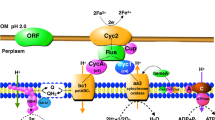Summary
The kinetics of oxidation of aqueous acidic ferrous sulphate by Thiobacillus ferrooxidans has been studied in a batch reactor. The contribution of cell wall envelopes to the oxidation rate has been shown to be negligible. A model which accounts for the oxidation of Fe2 +, death of bacteria due to Fe3 + poisoning, existence of an optimal pH and precipitation of Fe3 + has been proposed. The model is able to predict the concentration of Fe2 + and pH quite satisfactorily. The predictions of Fe3 + are not so accurate because of simplifying assumptions made about its precipitation.
Similar content being viewed by others
References
Bodo C, Lundgren DG (1974) Iron oxidation by cell envelopes of Thiobacillus ferrooxidans. Can J Microbiol 20:1647–1652
Ingledew JW, Cox JC, Halling PJ (1977) A proposed mechanism for energy conservation during Fe2 + oxidation by Thiobacillus ferrooxidans. FEMS Microbiol Lett 2:193–197
Lacey DT, Lawson F (1970) Kinetics of liquid phase oxidation of acid ferrous sulfate by the bacterium Thiobacillus ferrooxidans. Biotechnol Bioeng 12:29–50
Lundgren D, Tatsuo T (1978) Structure function relationship of Thiobacillus ferroxxidans relative to ferrous and sulfur oxidation. In: Murr LE, Torma AE, Brierley JR (eds) Metallurgical application of bacterial leaching and related phenomena. Academic Press, New York, pp 151–165
Paponetti LTB, Cantallini C (1988) Precipitation formation in the oxidation of Fe2 + in the presence of Thiobacillus ferroxxidans. Hydrometallurgy 20:1–9
Petrova TA (1985) A study of growth and development of Thiobacillus ferroxxidans w.r.t. oxidation of Fe2 + and sulfide minerals by means of mathematical modelling. In: Kavailay GI, Groudev SN (eds) International symposium on modern aspects of microbial hydrometallurgy and international training course on microbial leaching of metals from ores. Centre for international Projects, Gosusdarstvenni Komu′e′ Nauki Techniki, Moscow, pp 64–83
Silver M (1978) Mechanisms of iron oxidising Thiobacillus. In: Murr LE, Torma AE, Brierley JR (eds) Metallurgical application of bacterial leaching and related phenomena. Academic Press, New York, pp 3–14
Silverman MP, Lundrugen DG (1959) Studies on the chemoautotrophic iron bacterium Thiobacillus ferrooxxidans. I. An improved medium and a harvesting procedure for securing high cellular yields. J Bacteriol 77:642–647
Smith JR (1989) Evaluation of chemical and biological characteristics of ferric sulfate batch medium. PhD Thesis, Carnegie Mellon University, University Microfilms International Disertation Information Services, Pittsburgh
Torma AE (1977) The role of Thiobacillus ferrooxidans in hydrometallurgical processes. Adv Biochem Eng 6:1–37
Vogel AI (1961) A textbook of quantitative inorganic analysis, 3rd edn. Longman London
Author information
Authors and Affiliations
Additional information
Offprint requests to: R. Kumar
Rights and permissions
About this article
Cite this article
Kumar, S.R., Gandhi, K.S. Modelling of Fe2 + oxidation by Thiobacillus ferrooxidans . Appl Microbiol Biotechnol 33, 524–528 (1990). https://doi.org/10.1007/BF00172545
Received:
Accepted:
Issue Date:
DOI: https://doi.org/10.1007/BF00172545




